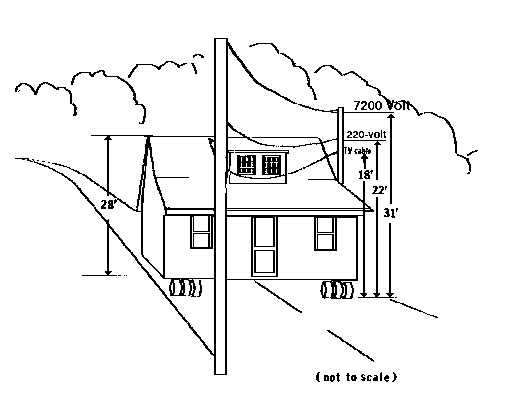36-Year-Old Laborer Electrocuted In North Carolina
FACE 87-02
Introduction
The National Institute for Occupational Safety and Health (NIOSH), Division of Safety Research (DSR) is currently conducting the Fatal Accident Circumstances and Epidemiology (FACE) Project, which is focusing primarily upon selected electrical-related and confined space-related fatalities. The purpose of the FACE program is to identify and rank factors that influence the risk of fatal injuries for selected employees.
On October 7, 1986, a house moving company was in the process of moving a house down a street. The victim was standing on the roof of the house, lifting up wires so that the wires would clear the top of the house. The laborer inadvertently contacted an energized 7200 volt power line and was electrocuted.
Contacts/Activities
Officials of the Occupational Safety and Health Program for the State of North Carolina notified the National Institute for Occupational Safety and Health (NIOSH), Division of Safety Research (DSR) of this fatality and requested technical assistance. This case has been included in the Fatal Accident Circumstances and Epidemiology (FACE) Project. On October 29, 1986, the DSR research team coordinator conducted a site visit, collected incident data, photographed the site, interviewed comparison workers, and discussed the incident with the state compliance officer and the employer representative.
Overview of Employer’s Safety Program
The victim was one of seven employed by a house moving company. The company had no written safety program. Safety training consisted of only telling the workers to be careful. The owner stated that all power lines were treated as if they were energized; however, there was only one pair of insulated gloves available for use in the company.
Synopsis of Events
On October 7, 1986, a house mounted on large truck dollies was being moved down a highway to a new location. The victim and another co-worker were standing on the roof of the house to ensure that the house could clear all overhead lines. At the time of the accident, the house was passing under three overhead lines: a cable TV line (18 feet above the road); an energized 220 volt, insulated line (22 feet above the road); and an energized 7200 volt, uninsulated line (31 foot above the road). (See Figure 1.) The peak of the roof was 28 feet above the road surface. The power company was preparing to de-energize a 220 volt, uninsulated line at the next intersection. The power company was not de-energizing low voltage (220 volts or less), insulated lines and did not de-energize the 7200 volt line at the time of the incident. Representatives of the power company told the workers which lines were energized and the workers acknowledged that they were aware of the energized lines. The co-worker was wearing rubber gloves, but the victim was not wearing any personal protective equipment. The house moving company had borrowed a hot stick from the telephone company, but were not using it at the time of the incident. This was the sixth house moved down this roadway during this particular house moving job. The five previous houses were moved without incident utilizing the same procedure. According to representatives of the power company, the 7200 volt line was energized on all five previous occasions.
After the 220 volt line had cleared the roof, the victim grabbed the cable TV line with both hands and stood up to walk the line over the top of the house. While doing this, the back of his neck came into contact with the 7200 volt line and he was electrocuted. The victim and the cable TV line provided a path to ground for the 220 volt line. The co-worker did not come into contact with the line.
After contact, the victim fell from the roof of the house to the roadway. Police personnel, who were at the scene directing traffic, provided initial cardiopulmonary resuscitation (CPR) until the emergency medical service (EMS) squad arrived to provide advanced cardiac life support. Attempts to resuscitate the victim were unsuccessful. The victim was then transported to a local hospital where he was pronounced dead.
Cause of Death
No autopsy was performed. Cause of death was listed as electrocution. Burn marks were on the back of the victim’s neck and palms of both hands.
Recommendations/Discussion
Recommendation #1: Employees working with energized conductors should wear required personal protective equipment.
Discussion: OSHA standards require employees to wear protective equipment when working around electrical hazards (1910.132). These standards identify specific types of insulated protective equipment to be worn by workers (1910.137). Protective equipment includes insulating gloves, blankets, hoods, line hose, and sleeves. There were only one pair of rubber gloves available from the company and the co-worker was wearing them.
Recommendation #2: All electrical lines should have been de-energized.
Discussion: All electrical lines should have been de-energized by the power company prior to the house being moved under the lines. The power company was on the scene de-energizing some of the lines, but not all of them. The victim would not have been electrocuted had this 7200 volt line been de-energized.
Recommendation #3: The employer should develop a safety program designed to recognize and correct hazards.
Discussion: The company does not provide training in safe work procedures nor are there any safety rules or written policies. None of the benefits that a safety program would provide (i.e., training, hazard identification, personal protective equipment, and safe operating procedures) were utilized.
Recommendation #4: Fall protection should be provided for employees while working on the roof of the house being moved.
Discussion: OSHA standards require employees to be protected from falls while working on elevated surfaces (1910.28). Employees working on the roof of the house should be protected by a safety belt attached to a lifeline which is secured to the house.

Figure 1.
